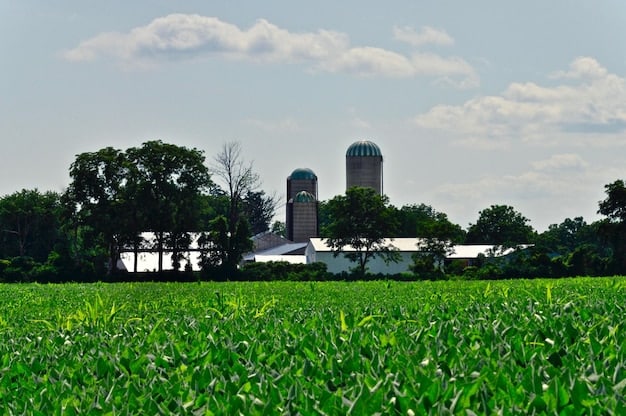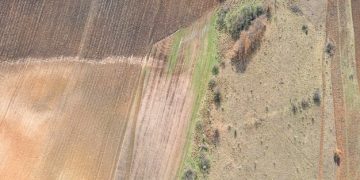Safeguarding Gardens: Extreme Weather & Food Security

Adapting food systems and home gardens to the escalating impacts of extreme weather events is crucial for maintaining local food security, requiring resilient strategies from soil health to community-based initiatives.
The intensifying shifts in global climate patterns are bringing forth more frequent and severe extreme weather events, posing unprecedented challenges to our food systems and individual gardens. Understanding how to protect your garden and local food supply amid these unpredictable conditions is no longer just a good idea; it’s becoming an essential component of sustainable living and community resilience. This article explores practical strategies and long-term solutions to bolster food security against the backdrop of a changing climate, offering insights into fostering robust agricultural practices at every scale, from the backyard plot to the broader community food network.
Understanding the Threat: How Extreme Weather Impacts Food Systems
Extreme weather events, ranging from prolonged droughts to torrential floods, and from unseasonable frosts to intense heatwaves, are increasingly disrupting agricultural cycles worldwide. These disruptions affect everything from crop yields and livestock health to the intricate supply chains that bring food to our tables. The unpredictability exacerbates existing vulnerabilities, making it difficult for farmers and gardeners to plan and adapt effectively.
Heatwaves, for instance, can lead to widespread crop wilting, reduced fruit set, and increased water demand, often straining already limited resources. Conversely, excessive rainfall can cause devastating floods, drowning crops, eroding topsoil, and fostering conditions ripe for fungal diseases. These singular events often cascade into broader problems, impacting food availability, prices, and the livelihoods of those dependent on agriculture.
Drought and Water Scarcity
Droughts are perhaps one of the most insidious threats, slowly but surely depleting water reserves vital for irrigation. Without adequate water, plant growth is stunted, and crops can fail entirely. This not only impacts current harvests but can also have long-term effects on soil health and the viability of future planting seasons.
- Reduced crop yields due to insufficient moisture.
- Increased competition for scarce water resources.
- Long-term degradation of soil structure and fertility.
- Economic hardship for agricultural communities.
Floods and Soil Erosion
While drought represents a lack of water, floods represent an excess, equally destructive. Flash floods can wash away entire fields, destroying infrastructure and contaminating water sources. Even less severe, prolonged periods of heavy rain can waterlog soil, leading to root rot, nutrient leaching, and significant soil erosion, crucial for long-term productivity.
The physical force of floodwaters can displace irrigation systems and damage harvesting equipment. Beyond immediate destruction, standing water can create anaerobic conditions in the soil, suffocating plant roots and promoting the growth of harmful pathogens. Recovering from flood damage often requires extensive and costly soil remediation efforts, often taking years to restore productivity.
Extreme Temperatures and Crop Vulnerability
Sudden drops in temperature, like late spring frosts, can decimate young plants and fruit blossoms, severely impacting yields for an entire season. Conversely, extreme heat can cause heat stress in plants, leading to premature ripening, reduced quality, and even complete crop failure, particularly in delicate vegetable varieties. These temperature fluctuations disrupt the delicate balance required for optimal plant development.
- Freezing temperatures damage sensitive plant tissues.
- Heat stress reduces photosynthesis and fruit development.
- Increased pest and disease pressure in changing climates.
- Shorter growing seasons due to unpredictable weather patterns.
Understanding these specific threats is the first step towards developing robust strategies for both personal gardens and broader food security initiatives. The interconnectedness of these challenges underscores the need for multi-faceted approaches that address both immediate impacts and long-term resilience building.
Building Resilient Gardens: Practical Strategies for Home Growers
For home gardeners, building resilience starts with thoughtful planning and adopting practices that help plants withstand the whims of extreme weather. It’s about creating a microclimate that offers protection and nurturing soil that acts as a buffer against environmental stress. These strategies empower individuals to maintain a degree of food self-sufficiency, even when nature throws its worst.
Choosing Resilient Varieties and Crop Diversification
One of the most effective strategies is selecting plant varieties known for their hardiness and adaptability to varying conditions. Heirloom seeds, often passed down through generations, frequently possess a genetic diversity that makes them more resilient than modern hybrids. Diversifying your crops, planting a wide range of vegetables, fruits, and herbs, also spreads the risk; if one crop fails due to specific weather, others may survive and thrive.
Researching local climate patterns and historical weather extremes can guide your selection process. Opt for varieties with early or late maturation times to avoid peak heat or frost periods. Consider perennial vegetables and fruit trees that establish deep root systems, making them inherently more tolerant to dry spells. Intercropping, planting different crops together, can also enhance resilience by fostering beneficial microclimates and pest control.
Optimizing Soil Health and Water Management
Healthy soil is the foundation of a resilient garden. Rich, organic-matter-laden soil acts like a sponge, improving water retention during dry periods and promoting better drainage during heavy rains. Incorporating compost, aged manure, and cover crops significantly enhances soil structure, microbial life, and nutrient availability, creating a robust environment for plant growth.

Efficient water management is equally critical. Practices such as drip irrigation or soaker hoses deliver water directly to the plant roots, minimizing evaporation and runoff. Rainwater harvesting systems, like rain barrels, provide a sustainable source of irrigation that reduces reliance on municipal water supplies, especially crucial during drought conditions.
- Regular application of compost and organic matter.
- Utilizing mulch to retain soil moisture and regulate temperature.
- Implementing efficient irrigation methods like drip systems.
- Harvesting rainwater for garden use.
Furthermore, understanding your soil type—whether it’s sandy, clay, or loamy—allows for tailored amendments to improve its water-holding capacity and drainage. Soil testing can provide insights into nutrient deficiencies, guiding you in adding the right organic amendments to create an ideal growing medium that supports robust plants even under stress.
Protective Structures and Techniques
Physical protection offers a direct line of defense against extreme weather. Row covers can shield young plants from sudden frosts and intense sun. Shade cloths can protect heat-sensitive crops during scorching summer days. Greenhouses and high tunnels extend the growing season and provide a more controlled environment, buffering plants from external temperature fluctuations and harsh winds.
For areas prone to high winds, windbreaks (either natural, like hedges, or artificial, like fences) can significantly reduce direct exposure and protect delicate plants. Raised beds can improve drainage in flood-prone areas, while container gardening offers flexibility, allowing plants to be moved indoors or to sheltered locations during severe weather events. These small-scale interventions collectively create a more secure gardening environment.
- Employing row covers for frost and pest protection.
- Using shade cloths to mitigate heat stress.
- Installing windbreaks to reduce damage from strong winds.
- Consideration of raised beds or container gardening for drainage and mobility.
Beyond these, consider the orientation of your garden to maximize sunlight in cooler months and provide natural shade during hotter periods. Strategic planting, where taller plants protect shorter, more sensitive ones, can also create beneficial microclimates. These protective measures, combined with healthy soil and diverse planting, significantly increase the garden’s ability to withstand extreme conditions.
Enhancing Local Food Supply: Community-Level Strategies
Protecting food security extends beyond the backyard garden; it encompasses the broader local food system. Building resilience at the community level involves fostering collaboration, supporting local producers, and establishing robust networks that can absorb shocks and ensure food access for everyone. This collective approach strengthens the entire food chain, making it less susceptible to external pressures.
Supporting Local Farmers and Farmers’ Markets
Investing in local agriculture is perhaps the most direct way to enhance regional food security. By purchasing directly from local farmers, either through farmers’ markets, Community Supported Agriculture (CSA) programs, or farm stands, consumers provide financial stability that enables farmers to invest in sustainable, resilient practices. This reduces reliance on long, vulnerable supply chains and keeps food production closer to home.
Local farmers, deeply familiar with the nuances of their specific microclimates and soil conditions, are often at the forefront of adapting to changing weather patterns. Supporting them directly fosters agricultural innovation and helps maintain diverse, region-specific crops that might otherwise be lost. It also builds stronger community ties and a shared stake in food resilience.
Developing Community Gardens and Urban Farms
Community gardens and urban farms play a vital role in increasing local food production and engaging residents in growing their own food. These initiatives transform underutilized spaces into productive plots, offering access to fresh produce for those without private land and fostering invaluable gardening skills within the community. Beyond food production, they build social capital, creating spaces for connection, education, and shared responsibility.
Many community gardens also serve as educational hubs, teaching participants about sustainable practices, water conservation, and climate-resilient gardening techniques. They often become vital resources during times of disruption, providing accessible food close to home while reducing transportation needs. Their localized nature makes them inherently more resilient to large-scale supply chain issues.
- Increased access to fresh produce for urban residents.
- Opportunities for skill-sharing and community building.
- Reduced food miles and carbon footprint.
- Enhanced local food self-sufficiency.
Moreover, these green spaces contribute positively to urban environments by improving air quality, supporting local biodiversity, and mitigating the urban heat island effect—all factors that indirectly support a healthier overall ecosystem for food production. The physical act of gardening also promotes physical and mental well-being, adding another layer of community resilience.
Establishing Food Hubs and Distribution Networks
Food hubs are critical infrastructure for local food systems, acting as central collection and distribution points for produce from multiple local farms. They streamline operations, allowing smaller farms to reach larger markets like schools, hospitals, and restaurants. By consolidating deliveries and managing logistics, food hubs improve efficiency and reduce transportation costs, making local food more accessible and competitive.
Beyond distribution, many food hubs offer services like aggregation, processing, and marketing support, which are invaluable for farmers. They also play a crucial role in enhancing food security during crises by facilitating the rapid redistribution of locally grown food. A well-developed network of food hubs strengthens the entire local food economy, making it more robust against external shocks.
- Streamlining logistics for local farmers.
- Connecting local produce with broader markets.
- Increasing the efficiency of food distribution.
- Providing resilience during supply chain disruptions.
Additionally, innovative distribution networks, such as direct-to-consumer models or partnerships with local businesses, can further shorten the path from farm to fork. These strategies help build a decentralized, redundant food system where various channels are available, reducing over-reliance on a single, potentially vulnerable pathway. The goal is to create a dynamic and interconnected system that can adapt and thrive.
Advanced Techniques for Climate Adaptation in Agriculture
Beyond immediate protective measures, a long-term vision for food security in a changing climate requires adopting advanced agricultural techniques that build deep, systemic resilience. These approaches often integrate scientific understanding with traditional ecological knowledge, aiming to work with natural processes rather than against them, fostering a more sustainable and productive future.
Agroecology and Ecological Farming
Agroecology is an approach to farming that applies ecological principles to agricultural systems. It focuses on creating diversified, sustainable, and resilient farms that mirror natural ecosystems. This includes practices like intercropping, crop rotation, cover cropping, and integrating livestock, all of which enhance biodiversity, improve soil health, and reduce reliance on external inputs like synthetic fertilizers and pesticides.
By mimicking natural processes, agroecological systems are inherently more stable and better able to withstand environmental stresses. Healthier soils, teeming with microbial life, are more effective at retaining water and nutrients, making plants more robust against drought or heavy rains. The diversity of crops also provides built-in resilience, as different species respond differently to varying weather conditions, ensuring some yield even if others fail.

This holistic approach goes beyond mere production, considering the social and economic dimensions of farming. It seeks to create equitable food systems that empower local communities and promote food sovereignty, making them more adaptable and self-sufficient in the face of climate challenges. Embracing agroecology means moving towards a regenerative agriculture that heals the land while feeding people.
Controlled Environment Agriculture (CEA)
Controlled Environment Agriculture (CEA) systems, such as vertical farms, hydroponics, and aeroponics, offer a promising solution to extreme weather variability. By growing crops indoors in highly regulated environments, these systems can control temperature, humidity, light, and nutrient delivery, regardless of external weather conditions. This allows for year-round production, higher yields per square foot, and significantly reduced water usage compared to traditional field farming.
While often capital-intensive, CEA provides a predictable and stable food source, reducing vulnerability to droughts, floods, and temperature extremes. It’s particularly valuable for urban areas where land is scarce and for growing high-value crops. As technology advances, these systems are becoming more energy-efficient and cost-effective, making them an increasingly viable component of future food security strategies.
- Year-round crop production independent of external weather.
- Significant reduction in water consumption.
- Higher yields in smaller footprints.
- Reduced need for pesticides due to controlled environments.
However, the successful implementation of CEA requires careful consideration of energy consumption and potential reliance on specialized equipment. Integrating renewable energy sources can mitigate environmental impact, positioning CEA as a vital tool for sustainable, localized food production in climate-stressed regions. This technology offers a paradigm shift in how and where we grow food.
Water Harvesting and Conservation Technologies
Given the increasing frequency of droughts, innovating in water harvesting and conservation is paramount. Beyond simple rain barrels, advanced systems include large-scale rainwater collection, greywater recycling for irrigation, and smart irrigation technologies that monitor soil moisture and weather forecasts to deliver water precisely when and where needed. These technologies vastly improve water use efficiency, crucial for both large farms and small gardens.
Techniques such as keyline design and contour plowing help landscapes capture and retain water more effectively, reducing runoff and promoting infiltration into the soil. Passive water harvesting structures like swales and terracing can transform arid or sloped land into productive agricultural zones. These combined efforts create a more water-secure agricultural landscape, making food production less vulnerable to periods of drought and ensuring the long-term sustainability of water resources.
- Large-scale rainwater collection systems.
- Greywater recycling for non-potable uses.
- Sensor-based smart irrigation.
- Landscape design for water retention and infiltration.
Furthermore, research into drought-resistant crops and the development of desalinization technologies for agricultural use are ongoing. While some are still emerging, they represent future frontiers in securing water access for food production in the face of escalating climate change challenges. The goal is to create a resilient water-food nexus that can withstand increasing environmental pressures.
Policy and Education: Fostering Systemic Resilience
While individual and community actions are vital, systemic change requires supportive policies and widespread education. Governments, academic institutions, and non-profits all have a role to play in creating an enabling environment for climate-resilient food systems. This involves investing in research, providing incentives, and empowering diverse communities with the knowledge and resources to adapt.
Government Support and Agricultural Policies
Effective government policies are crucial for fostering climate adaptation in agriculture. This includes funding for research into drought-resistant crops, flood-mitigation techniques, and sustainable farming practices. Subsidies can encourage farmers to adopt resilient methods, such as cover cropping, no-till farming, and diversifying crop rotations. Disaster relief programs are also essential to help farmers recover from extreme weather events.
Beyond direct financial support, policies can promote resilient practices by integrating climate risk assessment into agricultural planning and land-use regulations. Incentives for local food procurement by public institutions (schools, hospitals) can also strengthen regional food systems. Ultimately, a proactive policy framework that prioritizes long-term resilience over short-term production gains is essential for widespread adaptation.
- Funding for climate resilience research in agriculture.
- Incentives for adopting sustainable and adaptive farming practices.
- Robust disaster relief and recovery programs.
- Policies promoting local food procurement.
Moreover, streamlined regulatory processes for innovative agricultural technologies, such as advanced irrigation systems or vertical farming, can accelerate their adoption. International cooperation and knowledge sharing on best practices for climate-resilient agriculture are also vital, as climate change impacts transcend national borders, demanding a global response.
Education and Community Outreach
Knowledge is power, especially when it comes to adapting to climate change. Educational initiatives are vital to inform both farmers and the general public about the impacts of extreme weather on food and the strategies for resilience. Workshops, online resources, and community forums can disseminate practical gardening and farming techniques, from water conservation to soil health management.
Community outreach programs can empower individuals to start home gardens, participate in community farms, or support local food initiatives. Integrating climate resilience into agricultural education curricula at all levels, from vocational schools to universities, ensures that future generations of farmers and food system professionals are equipped with the necessary skills and understanding to navigate a changing climate.
These efforts should also focus on vulnerable communities, ensuring equitable access to information and resources for adaptation. Empowering citizens with knowledge creates a more informed and engaged populace, capable of making resilient choices for their own food security and advocating for broader systemic change. Education sows the seeds for a resilient future.
Information Sharing and Early Warning Systems
Effective information sharing and early warning systems are critical tools for building resilience. Farmers need timely and accurate weather forecasts, climate projections, and data on soil moisture and pest outbreaks to make informed decisions. Advanced meteorological services, coupled with agricultural extension services, can deliver vital information directly to growers, allowing them to prepare for impending extreme weather events.
Digital platforms and mobile applications can facilitate the rapid dissemination of advisories and best practices. Establishing farmer-to-farmer networks and peer-learning initiatives also allows growers to share their experiences and adaptive strategies. This collective knowledge base is invaluable, especially as local conditions vary and require region-specific solutions. Real-time data and collaborative knowledge empower proactive adaptation rather than reactive recovery.
- Access to accurate and timely weather forecasts.
- Dissemination of climate projections and agricultural advisories.
- Development of user-friendly digital tools for farmers.
- Facilitation of peer-to-peer knowledge exchange networks.
The integration of traditional ecological knowledge with modern scientific data can further enrich these information systems, providing a more holistic understanding of local environmental dynamics. By strengthening these information channels, communities can build a more agile and responsive food system, capable of anticipating and mitigating the impacts of extreme weather more effectively.
The Role of Technology and Innovation
Technological advancements offer a beacon of hope in the quest for food security amidst extreme weather. From precision agriculture to genetic innovation, these tools provide new ways to monitor, adapt, and enhance food production, allowing us to cultivate more efficiently and sustainably, even in challenging conditions. Embracing these innovations is key to future resilience.
Precision Agriculture and Data Analytics
Precision agriculture integrates cutting-edge technologies like sensors, drones, and satellite imagery to collect vast amounts of data on crop health, soil conditions, and water needs. This information allows farmers to make highly localized decisions, optimizing resource allocation and improving efficiency. For example, remote sensors can detect early signs of drought stress or nutrient deficiencies, enabling timely interventions that prevent significant crop loss.
Data analytics transforms this raw information into actionable insights, providing detailed maps of field variability and predictions of future conditions. This enables targeted application of water, fertilizers, and pesticides, reducing waste and environmental impact. During extreme weather events, real-time data can help assess damage quickly and guide recovery efforts, making farming more responsive and resilient.
Genomic Tools and Crop Breeding
Advances in genomics and selective breeding are leading to the development of new crop varieties specifically engineered for climate resilience. Scientists are identifying genes that confer resistance to drought, heat, flood, and new diseases. This allows for the breeding of crops that can thrive in harsher conditions, extending growing regions and improving yields in already challenging environments. For instance, new rice varieties are being developed that can tolerate long periods underwater, crucial for flood-prone regions.
While genetically modified organisms (GMOs) have been a subject of debate, conventional breeding techniques also benefit from genomic insights, accelerating the development of robust, climate-adapted varieties. This focus on genetic resilience is a long-term strategy that provides foundational strength to our food supply, ensuring that the ‘building blocks’ of our food are better equipped to face future climate challenges. These innovations provide foundational strength to our food supply.
- Development of drought-tolerant crops.
- Breeding for heat and cold resistance.
- Enhancing flood tolerance in staple crops.
- Improving disease resistance in new varieties.
Furthermore, understanding the genetic diversity of traditional and heirloom varieties can help researchers identify existing traits that may be valuable in future breeding programs, bridging the gap between modern science and ancient wisdom. This approach seeks to safeguard biodiversity while strengthening food production capabilities.
Renewable Energy Integration in Farming
Integrating renewable energy sources into agricultural operations enhances sustainability and resilience. Solar panels can power irrigation systems, greenhouses, and processing facilities, reducing reliance on fossil fuels and protecting against energy price volatility. Wind turbines can similarly provide clean energy for farms, particularly in remote areas.
Beyond energy production, renewable technologies can improve food storage and processing. Solar-powered cold storage units, for instance, are vital in helping farmers preserve perishable produce, reducing post-harvest losses, especially in regions with unreliable electricity access. By decarbonizing agriculture, we not only combat climate change but also build more self-sufficient and shock-resistant food systems. This self-sufficiency supports overall food security and operational stability for farmers.
- Powering irrigation systems with solar energy.
- Utilizing wind power for farm operations.
- Solar-powered cold storage to reduce food waste.
- Reducing reliance on fossil fuels for agricultural processes.
The adoption of these technologies also creates new economic opportunities, fostering a more sustainable rural economy. Investing in a renewable-powered agricultural sector is a critical step towards a greener, more secure food future, ensuring that the production of food is harmonious with the environment rather than detrimental to it.
| Key Point | Brief Description |
|---|---|
| 🌱 Resilient Gardens | Choose hardy varieties, build soil health, and use protective structures. |
| 👨🌾 Local Food Security | Support local farmers, community gardens, and robust food distribution. |
| 🔬 Advanced Adaptation | Implement agroecology, CEA, and water conservation technologies. |
| 🏛️ Policy & Tech | Advocate for supportive policies, widespread education, and technological innovation. |
Frequently asked questions about extreme weather & food security
▼
Extreme heat can cause significant stress to garden plants, leading to wilting, reduced fruiting, and even plant death. It can also dry out the soil rapidly, increase water demand, and make plants more susceptible to pests and diseases due to weakened immune systems. Providing shade and consistent watering are crucial responses.
▼
Effective water conservation in gardens includes using drip irrigation systems, applying thick layers of mulch to retain soil moisture, collecting rainwater in barrels, and planting drought-tolerant native species. Improving soil health with organic matter also significantly enhances its water-holding capacity, reducing the need for frequent irrigation.
▼
Community gardens increase local food access, especially for those without private growing spaces, and foster gardening skills. They reduce reliance on distant supply chains, shorten “food miles,” and build stronger community ties, creating valuable local food sources and resilience during market disruptions or supply shortages caused by extreme weather.
▼
Diversifying crops by planting a variety of species, from different families or with varied growth cycles, significantly increases a garden’s resilience. If one crop fails due to a specific weather event, others are likely to survive. This strategy helps ensure a more stable overall yield and reduces the risk of total crop loss, providing a form of natural insurance.
▼
Government policies can greatly bolster food security by funding climate-resilient agriculture research, incentivizing sustainable farming practices, and establishing robust disaster relief programs. Policies promoting local food systems and investing in infrastructure like food hubs can also create more stable and less vulnerable supply chains.
Conclusion
Protecting our gardens and local food supply in an era of escalating extreme weather events requires a multi-pronged approach that integrates individual action with community-level initiatives and systemic policy changes. By adopting resilient gardening practices, fostering robust local food systems, embracing technological innovation, and advocating for supportive policies, we can build a more secure and sustainable food future. The journey towards food security is a shared responsibility, demanding continuous adaptation, collaboration, and a deep respect for the intricate balance of nature.





